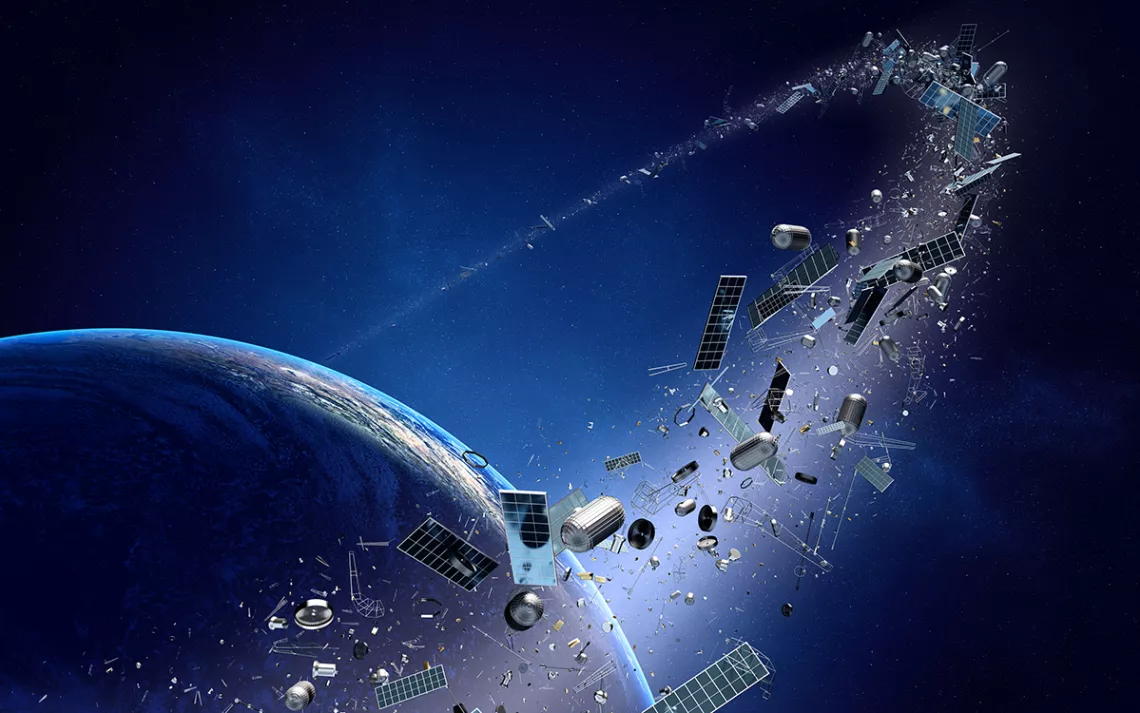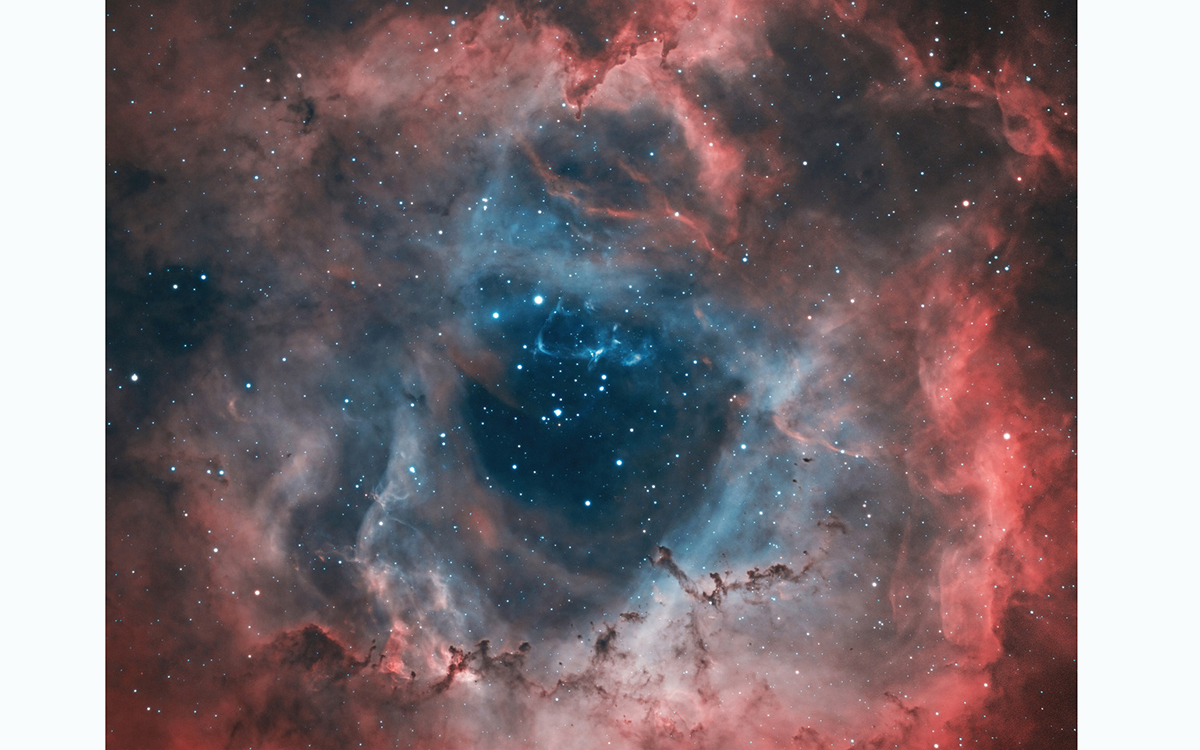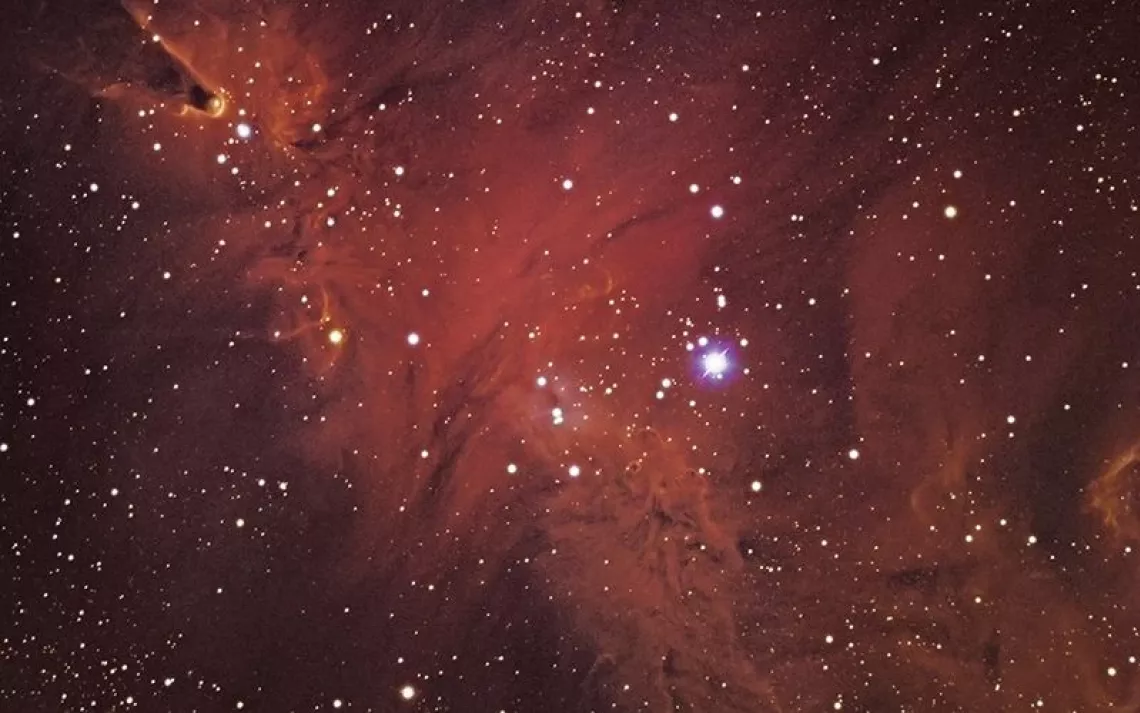December Stargazing: Trashing Space
Humans treat space like we treat the planet

Photo by johan63/iStock
In November, the Russian defense ministry carried out an audacious test on an old Russian satellite traveling 300 miles above Earth. Usually, countries remove nonfunctional satellites from orbit by forcing them to crash—upon reentering the atmosphere, the satellites conveniently burn up. This time though, the Russians launched an anti-satellite missile, or DA-ASAT, at the defunct satellite.
The test was, on one level, a success. The missile struck its target. But the explosion reduced the satellite to thousands of pieces of ragged shrapnel—some of it moving at speeds of 17,000 miles per hour and threatening other objects in orbit. Crewmembers aboard the International Space Station were told to shelter in space capsules as the station passed through the debris cloud. Experts feared that a collision with even the smallest fragments could cause critical damage.
The ISS and its crew were unharmed, but condemnation from the international community was swift. Florence Parly, the French minister of the armed forces, described the launch as an act of “vandalism,” and a violation of space as a “common good.” Secretary of State Antony Blinken called the test “dangerous and irresponsible” (though he did not mention that the US has, itself, conducted similar tests since the 1950s). Russian officials downplayed the incident, asserting that the nation is “not militarizing space.” It’s still not entirely clear why the Russians chose to scuttle the satellite when they did, but it seems that the test was a practice run at shooting down satellites of military adversaries.
For more than a half century, humans have been launching rockets, sending satellites into orbit, and building space stations. Those efforts have generated a beehive of debris. Most of the pieces are small—shards of metal, bolts and screws, flecks of paint, wafers of insulation. But other fragments are much larger. Hundreds of rocket parts and dead satellites the size of school buses drift in the darkness. And that is becoming a serious problem. “Imagine how dangerous sailing the high seas would be if all the ships ever lost in history were still drifting on top of the water,” says the European Space Agency's director general Jan Wörner. “That is the current situation in orbit, and it cannot be allowed to continue.”
All this space junk is concentrated in a thin and increasingly crowded shell around Earth known as low Earth orbit. Today, some 7,500 satellites inhabit this shell—but tens of thousands more are planned for the years ahead. Elon Musk’s SpaceX Starlink satellite program has, to date, sent around 1,800 satellites into space. “Trains” of these satellites can often be seen marching across the sky in long, flickering processions. When fully operational, the Starlink “constellation” will consist of as many as 42,000 satellites and beam internet service down to every nook and cranny of the planet. Others have proposed even more ambitious plans. In October, the African nation of Rwanda proposed to launch a massive constellation of 327,000 communication satellites in a project known as CINNAMON.
This growing number of satellites is interfering with astronomical research (and amateur astronomy) conducted from telescopes on the planet’s surface. The expanding ring of flotsam also poses a threat to satellite networks themselves—and in a worst-case scenario could render huge regions of orbit unusable.
The more stuff we shoot into orbit, the greater the risk we create. The Kessler syndrome (named for former NASA scientist Donald Kessler) describes how collisions can trigger a chain reaction in which one impact creates thousands of pieces of debris, each with the potential to careen into other satellites and space stations. Each of those impacts, in turn, could create its own shower of debris, eventually leading to a runaway “cascade” of destructive and potentially lethal space trash. The physics of the Kessler syndrome was demonstrated in breathtaking CGI in the 2013 movie Gravity, as astronaut Dr. Ryan Stone, played by Sandra Bullock, struggles to survive after her space station is shredded by debris from a satellite destroyed by, of all things, a Russian missile.
Moriba Jah, an engineering professor at the University of Texas, has made it his mission to quantify the growing cloud of space junk in orbit around the planet. Jah’s publicly accessible website, Astria, makes visual the roughly 20,000 pieces of debris—from active satellites to discarded rocket bodies—currently being tracked in Earth’s orbit. (Mind you, this is a small fraction of the millions of smaller pieces whizzing around the planet.) “We are operating in [space] well beyond our ability to make sound and sustainable decisions,” Jah said in a 2020 Senate hearing, “and this will be to our eventual detriment.”
As last month’s satellite affair illustrates, we need a new kind of international governance, one that seeks to reduce the potential for conflict as well as the trashing of space. A framework already exists. In 1967, at the height of the Cold War, the US, UK, and Soviet Union signed the Outer Space Treaty. The 54-year-old document states that space should be governed as “the province of all mankind.” But the document’s language is vague and provides scant framework for enforcement.
In the search for intelligent life on other planets, some have proposed that we look for evidence of space junk. (The underlying idea seems to be that a civilization’s technological prowess is proportional to its capacity to pollute.) Physicist Freeman Dyson proposed that advanced civilizations may have constructed elaborate satellite networks or shells of solar arrays around stars to harness their energy.
I wonder, though, if the ability to produce prodigious quantities of space junk is really a sign of an advanced civilization—or one on the path to self-destruction. The small sliver of space around our planet is infinitesimal, of course, when compared with the yawning ocean of the cosmos. But it is also the one realm of space currently under our control. Our choice to treat it as a battleground and a scrap heap is, I think, a powerful message to the rest of the universe about where we, as a species, are headed.
WHAT TO LOOK FOR IN DECEMBER
The astronomical possibilities rise as we press into the long nights of December. The sky is rearranging itself, and the iconic objects of winter are beginning to take center stage. The constellation Cassiopeia will dominate northern skies. The shape of Cassiopeia, the queen, is unmistakable. Its five brightest stars make a letter “W” (though at this time of year, the W is tilted on end and looks like a backward letter “E”). The constellation’s brightest star, Shedar, is found in the right upper crook of the letter E. Not far from Shedar is SN 1572, a remnant of a bright light in the sky that appeared on November 11, 1572. The Danish astronomer Tycho Brahe described the object as a “new star.” Today it is often referred to simply as the Tycho supernova remnant. The brash, prosthetic-nose-wearing Brahe lambasted his rivals who believed the object was close to Earth and not, as Brahe understood, very far away among the stars.
Another spectacular sight in the early winter skies is found in the constellation Monoceros, near Orion, the Hunter. Within the constellation is the beautiful Rosette Nebula, a huge gas cloud in whose contours earth-bound viewers see the shape of a rose—an enormous one that is 130 light-years across. But it can all be taken in through the lens of a telescope because of its great distance, some 1,500 years from Earth. Scientists have counted around 2,500 young stars emerging from its gaseous core. Those interested in seeking out the Rosette will need dark skies and a telescope and can find it roughly a palm’s length to the left of the bright-red star Betelgeuse, in Orion.

Photo by Jeremy Miller
The December full moon, the Cold Moon, will rise on the 18th. It comes just three days before the Winter Solstice, the longest night of the year. Take advantage of the darkness and see how many stars and satellites you can count crawling across the skies overhead.
 The Magazine of The Sierra Club
The Magazine of The Sierra Club



